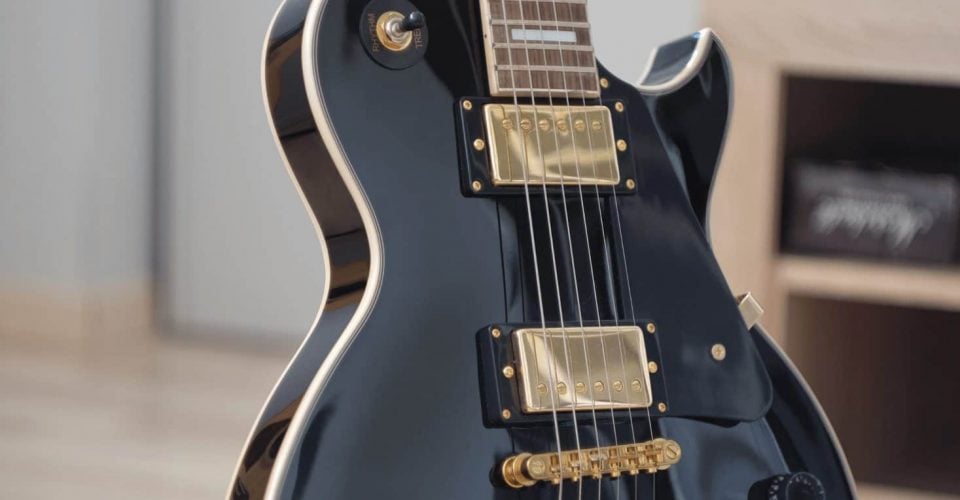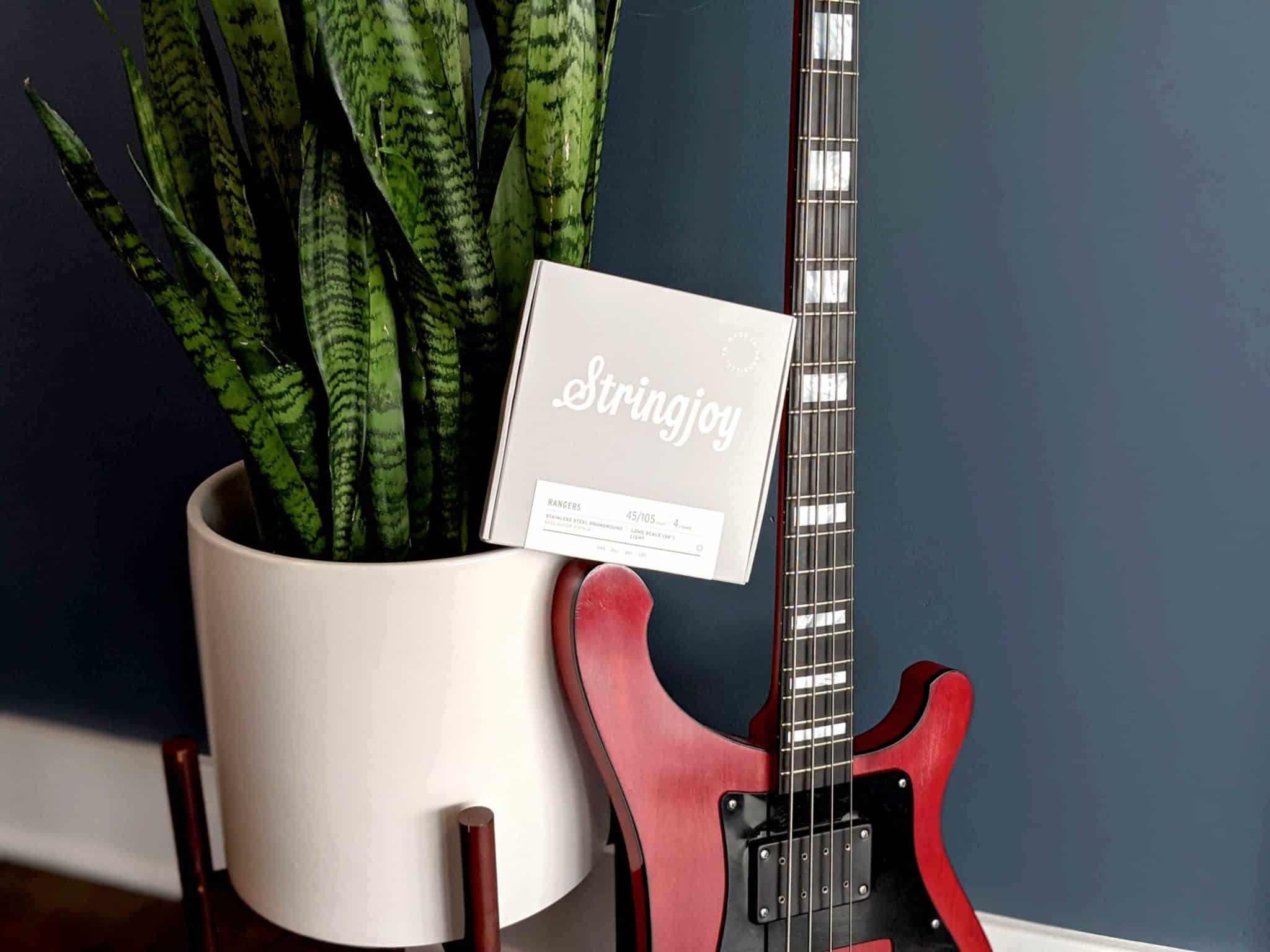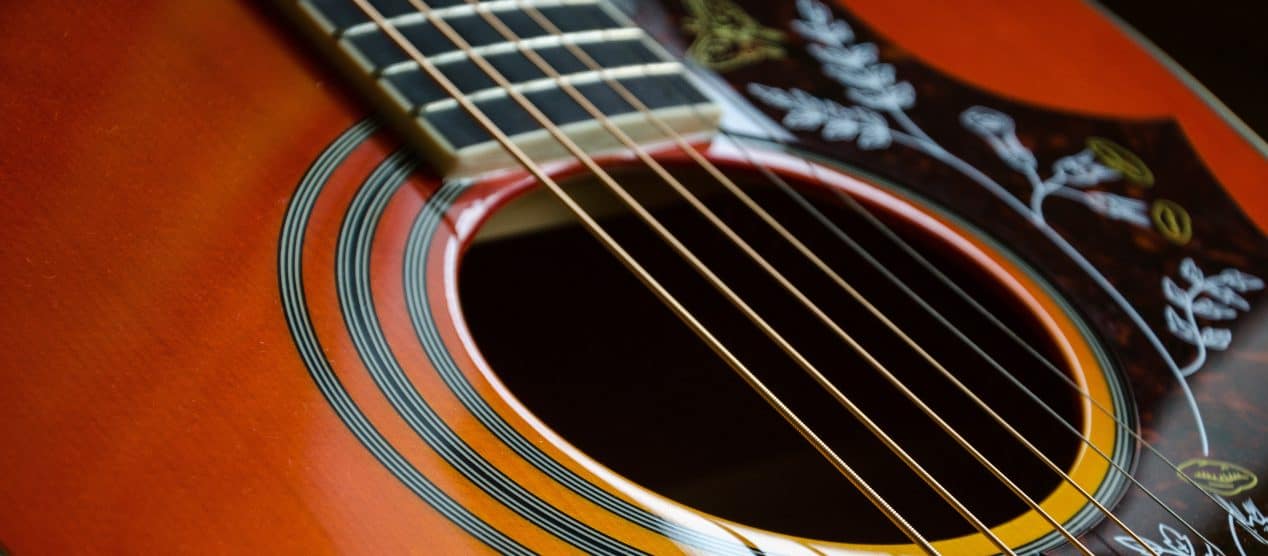What advantages or disadvantages does top wrapping guitar strings on a Les Paul or Tune-O-Matic style tailpiece have? Should you try it on your own guitar? Let’s talk about it:
Be sure to subscribe to our YouTube channel to keep up with more great videos like this one:
Transcription
What’s up everybody? I’m Scott from Stringjoy Guitar Strings and today we are talking about top wrapping with Tune-o-matic tailpieces. We’re going to talk about what advantages it might provide, whether those are legit or not and how you would go about doing it on one of your own guitars.
Let’s start with the basics. On a typical two-piece Tune-o-matic bridge like you see on most Gibson-style guitars, the strings are supposed to go through the back of the tailpiece and then come up over the bridge. When you top wrap it, instead of going to the back of the tailpiece, you actually put the strings in through the front of the tailpiece and then wrap the strings over top of the tailpiece and then they go over the bridge.
This method of wrapping guitar strings over the tailpiece is by no means favored by a majority of people that play Gibsons but there’s always been a pretty vocal minority of players that do prefer it. What do they like about it?
The first reason that a lot of players cite that prefer top wrapping is that they get a little bit more string slinkiness. They say that because of the shallower break angle the strings feel a little bit more flexible when they’re playing or when they’re bending even if they’re not using that thin of a gauge of strings. The second thing that a lot of players report is that they get a little bit more sustain out of the guitar. The best reasoning behind this would be that you’re able to secure your tailpiece all the way down the guitar allowing for a little bit more of an efficient transfer of energy between the bridge and the guitar.
I don’t know whether this is true or not. I’d say you probably have to try it out for yourself and see what you feel like. It makes sense that securing your bridge all the way down would help to transfer that energy a little bit more easily to the body of the guitar but at the same time, you can screw it all the way down and go in the traditional way as well so it kind of just depends on your taste there or how you usually like to set up your bridge.
Now, there are a couple of disadvantages as well that are worth weighing when you’re considering top wrapping your guitar. The first is that you run the risk of scuffing up your tailpiece just slightly. You have strings going over the top of it at tension which is not normally what happens with these tailpieces. So it is possible that you could get a little bit of scuffing. That just kind of depends on how much of an importance you place on having a really clean tailpiece.
The second disadvantage is that you’re placing a very severe break angle on your strings which could potentially result in more string breakage. Again, player reviews kind of vary. Some people feel that it’s not a problem at all. Some people have tried it and feel that it just doesn’t really work for them. So I’d recommend trying it and seeing if it becomes an issue. Strings don’t cost all that much so it’s not the biggest deal if you do break some. But there is evidence to support that going at that severe of a break angle where the string is in tension could result in an increase of breakage just depending on a number of factors, like what gauge you use, how well you set it up and how hard you are on your strings.
So let’s get into it. We’re going to top wrap this little Epi 339 and we’re going to see what that process looks like and talk about a couple little tricks that might make it a little bit easier for you. All right. So today we’re using a set of our Balanced Light 10-48 electric guitar strings. We’re going to start with the fourth string in the set which is a 26 wound just to make it a little bit easier.
So, basically all we’re doing here is going in backwards and then stringing up as normal. But I want to talk about one thing we encounter here. When we pull the string like this, as you can see, the bottom end of the string where we have a double wrap where the string is initially twisted around the core wire is going to be a little bit more firm that the rest of the string. So we can see it kind of sticking out at the back end there.
Now, you can just wrap this up as is but it might not secure all the way to the back of the tailpiece because, again, that fatter bottom end of the string is going to stick out just a little bit. But, the good news is, we have a trick for this. So I’m going to pull this back out and I’m going to show you what you can do to stop from having this sort of sharp edge at the back end of your tailpiece.
One trick that’s been used by techs for a long time that helps you be able to top wrap without having that little bottom end of string sticking out in a very sharp way out of the back of your bridge, is to take another string … I’m using a new one because I’ve got a lot of strings here but you can also just use older strings if you don’t want to waste anything.
What we’re looking for is the ball end of the string. Basically we just want to clip right ahead of the ball end, make sure that we have just the clean ball end. We don’t have the loop attached to it or anything like that. Then we take the tail end of the string, we thread the ball end through and pull it all the way down to the very bottom next to the other ball end. This will give us a little bit more space when we go to that Tune-o-matic bridge which will enable it to pull together in a little bit more smooth of a fashion. So let’s see what that looks like.
All right. As you can see this time the bottom end of the string cleanly wraps around. We don’t have any sharp edges or any really rough break angle on the bottom fatter part of the string there. So basically you just want to find six ball ends. You can use them forever as long as you remember to take them off. So if you’ve got an old set of strings and you’re doing this anyway, just remember to hang on to them and clip those ball ends because they’re going to come in handy if you don’t want that sharper edge at the back end there.
Now we’re going to do the same thing on every single string. We’re going to tighten everything as normal and we’re going to see what it looks like when it’s all finished up. All right. So we’ve got everything top wrapped. We’ve got a whole new set of strings thrown on here. A couple quick observations.
For one, I don’t know if anybody has a trick for this that I don’t know but it’s a little bit hard to get these very even in terms of how they’re coming over top of that back end of the Tune-o-matic bridge. You can see they’re a little bit uneven there. I wouldn’t prefer it to be that way but I’m not sure, short of cutting slots or something into there, of a good way of remedying that. If anybody knows, by the way, leave something in the comments.
Otherwise we have everything going on here. I did notice that it’s kind of hard to keep all those ball ends from flying away on you. I thought I could just recycle some from an old set of strings but I ended up having to just get some ball ends from downstairs because I lost like three of them. So if you’re using the same six of them, find a good safe space to put them in why you’re changing because it’s pretty easy for those to get lost. Anyway, let’s see what she sounds like and see what first impressions are.
Interesting. So my first impressions are I can definitely seem to feel the slinkiness caused by that smoother break angle over the bridge. It seems like this low E which is a 48 in our Balanced 10 set can bend a lot further than I’m typically used to. Again, I’m not A-B-ing it with one of the same guitar without it being top wrapped so it’s hard to say for sure but at least in terms of how it feels, it definitely feels like there is some more slinkiness.
I will say that to me just listening to the acoustic tone of the guitar which I think is usually the best barometer for things like this, I don’t feel like I’m getting quite the sustain that some people have talked about. On top of that, some of the gauges kind of feel a little bit plasticky, this G doesn’t feel like it has the same resonance that I feel like it ought to and I expect that it has to do with the top wrapping.
I suppose for anybody out there it’s just going to come down to personal taste. Whether you feel like the tone’s just fine and the slinkiness is really great for you kind of just depends on your particular flavor or what you’re into.
One thing that I will say that’s another potential drawback is that when you’re using the ball end trick like I did, to try to stop from getting those sharp twists coming over the top of that Tune-o-matic bridge, it seems to me that that could cause some tuning stability issues in the long run. If everything gets seated just right it’d be okay but you can’t really see down there to see how well those ball ends are seated in the Tune-o-matic bridge. If they’re off kilter a little bit then you run the risk of them moving around a little bit on you. It’s certainly not going to be quite as consistent as if you have your ball ends anchored the traditional way in the Tune-o-matic bridge.
But all that said, there’s a lot of great players that really like playing this way. Try it. If you like it, stick with it. If not or if you experience tuning issues or breakage issues or tone issues, then well, you’re only out a set of strings.
So what do you think? Are you a prodigious top wrapper? Is it the only way you play your Gibson-style guitars? Do you think that it’s dumb or are you like me and just kind of lukewarm on it? Share your experience down in the comments.









9 Responses
I play nearly 7 days a week in Nashville and I just break strings on my Les Paul like crazy, instead Of messing with others saddles and other permanent mods, this simply works. Tone/sustain, I don’t think is much different, “slinkier” feel, yes which I see as meaningless…. BUT I don’t break strings as much. So for a guy who already goes through 3 packs a week this is a worthy mod.
Les Paul and SG specials are designed to have to strings wrapped over the tail piece so the studs in the body were designed to do that
Absolutely! Those are called “wraparound” bridges and work that way by default. This article is about adapting a tune-o-matic style bridge to work the same way as a wraparound bridge.
i just tried it tonight. It’s a keeper for the guitar I tried it on. I tried it once 40 years ago on my LP Deluxe, it was as no go, no advantage, and I don’t recall but probably didn’t sound right. I have a 2020 LP 50’s Standard, which was great normally, but when changing strings I had an impulsive thought, why not? Interestingly, I had to raise the bridge treble end a little, buzzing. The guitar plays way smoother, and the strings are sitting lower now, and more even. There is no noticeable sustain increase, just a tiny it more of a slinky feel a little less tension, and a tiny bit of tone loss. I heard a little more wood before, but it’s okay. I’m willing to give up those 5% differences for a 25% gain in playability. It’s dramatic on this build. I’m glad I tried it. I am 100% sure that it depends on the guitar, and the guitarist. It’s probably going to be winner or loser mostly on the neck pitch/angle and things like that. i will try it in the future on my buddy’s 60’s standard, and try to post what the result on his axe is. Note, I have medium sized hands, and the 50’s neck profile is a bit thicker than the 60’s and many other LPs. I beliee the neck angle is also a bit different. The results of this being a benefit are going depend on these and other build factors. I’m thinking a player with larger hands may not notice as much benefit, for me the guitar is just easier to play.
I’m sold on it now. Never tried it for 30 plus years, tried it last year and now all my les Paul’s – USA and custom shops are top wrapped. Definetily more slinky for string bends. Night and day actually. Not sure about sustain difference but the feel of the strings is so much better for me.
Too wrap now forever. Everyone should try it, until you do you’ll never know.
allman, bolan and gibbons custom les pauls top wrap over the tailpiece…
There always is something going people claim is the new “cool thing” I worked at a music store a long time ago and learned that this “top wrapping” might be good for sustain, but is a kind of fad instead of a way of improving on the playability of the guitar. If top wrapping was an improvement Gibson would find a way to incorporate that into their guitars.
So I do agree that it’s not an improvement per se, but for what it’s worth, there are many Gibson guitars that come standard with wraparound bridges.
I’ve never tried top wrapping and it seems to me that you would be putting stress on the studs and the wood they are anchored to in directions they were not designed for. Of course I might just be over-thinking this. Now that I think of it wouldn’t just raising the height of the tailpiece pretty much have the same effect? If there is a loss of sustain when the tailpiece is not tightened all the way down I haven’t noticed it on my SG.